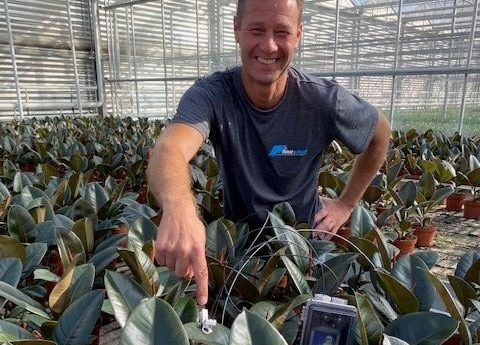
Genealogiecode: C X ab.3
Bron: sendot.nl
Door: sendot.nl
Foto: sendot.nl
Jaco: “the workspace of Pantar in Amsterdam is a Venlo-type greenhouse 10.000 m2 in size, used for various horticulture-related activities performed by people who struggle to access work due to various reasons, disabilities being one of them. Part of the greenhouse is being used for plant-cutting, assembly-related activities and more, often commissioned by horticultural suppliers. Another part of the greenhouse is used for the growing of juvenile plants for plant breeders. We also grow our own plants in this greenhouse.”
Greenhouse in Amsterdam
The Seineweg-location is run by Jaco Vreugdenhil, a Westlandian in heart and soul, who leads around 250 people and who’s responsible for growing the different plant variaties. Under his inspiring leadership people are trained to levels which allows them to eventually reach positions in other companies. As hardcore Westlandian and experienced company director Jaco Vreugdenhil has a weakness for plants ánd people. He enjoys the daily drive from the Glass City (Westland region) to Amsterdam, where the 15.000M2 business of the sheltered learning and work organization is located. At the edge of the Westpoort harbour-area he teaches his people basic knowledge and skills needed at a pot plant nursery. “Aalsmeer has more than enough of those nurseries and I love teaching people with a disability the skills to work there. Traning and transferring is our main goal,” he says with conviction. “We think in possibilities, not in disabilities.”
Digitalization
This way of thinking Vreugdenhil also uses in the cultivation of ficus plants, their main plant species. “We have a 10.000 M2 greenhouse, divided into four departments each with a different climate,” he adds. “Three are meant for the ficus plants, and in the fourth we cultivate Sundaville plants.”
New insights
During the spring of 2020 the greenhouse got a photosynthesis sensor and an oxygen meter. Since then, Vreugdenhil has used both and within two weeks he noticed that they needed a fundamental change of course. “We were used to watering during the day, which is standard in commercial companies,” the director explains. “However, the photosynthesis and oxygen measurements showed that the level of water in each pot stayed too high for too long, which stressed the plants, preventing them from optimal growth.” As a test Vreugdenhil started watering in the evening, so that the pots could get rid of surplus water during the non-active nights and the roots had enough oxygen the moment it became light again. “According to our photosynthesis measurements this was the golden egg,” the grower says enthusiastically. “After a few weeks I could clearly see the results when looking at the root-systems which had become finer and stronger. And the plants itself, instead of their usual compact size, had become significantly larger. It might sound easy, but without those sensor I’d still be working like before.”
Guaranteed quality
“Another positive resulting from the use of the Sendot sensors is that we can guarantee a much higher quality level in our plants than before, and that we have more control over the process. Our customers significantly profit from these results,” according to Vreugdenhil.
“The best part of my job is that I can let both plants and people grown.”

Genealogiecode: C X ab.3
Bron: sendot.nl
Door: sendot.nl
Foto: sendot.nl
“I also think it’s very important that we can continue giving people the enthusiasm and skills that allows them to find a fitting job within greenhouse horticulture.”
